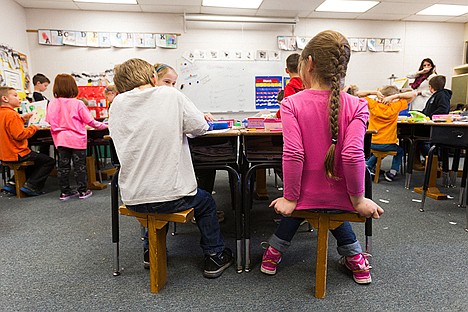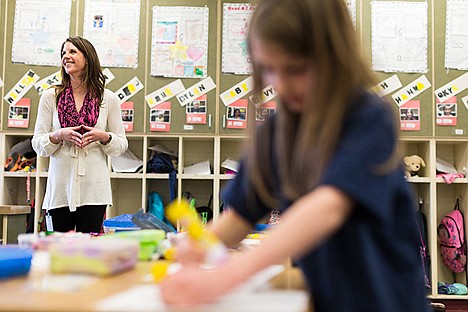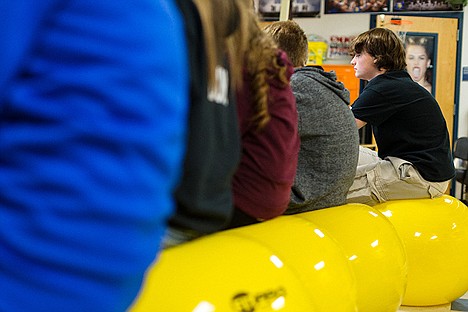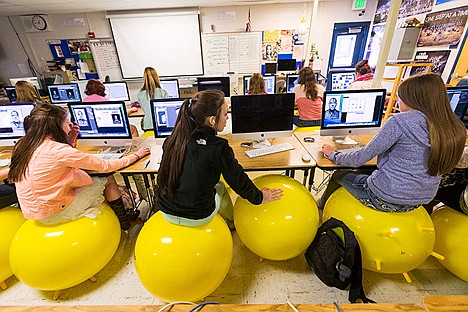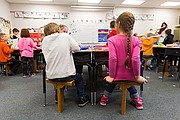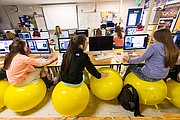Sitting, studying
David Cole | Hagadone News Network | UPDATED 11 years, 9 months AGO
COEUR d’ALENE — Slouching isn’t an option on the T-chair.
First-grade teacher Casey Campbell, at Ramsey Magnet School of Science, has been introducing the simple seats to her classes for several years, in both Coeur d’Alene and previously in Arizona.
“I give the kids the option of sitting in a regular chair, a T-chair, or standing when they do their desk work,” Campbell said. “Options are good, and kids learn in different ways.”
The kids don’t squirm or move around in their T-chairs like a typical desk chair, but the students are 6 or 7 years old so there is always going to be some squirming.
Exercise balls were not an acceptable alternative chair for her students, because they are too bouncy and might end up rolling around the room, she said.
Exercise, or yoga, balls might work for older students.
This past week, Bruce Twitchell, a Coeur d’Alene High School photography teacher, equipped his entire classroom with exercise balls.
“There are 32 blown up and there are two just in case — because kids can be kids,” he said. “It’s going quite well. There are a couple of kids who say they don’t like it.”
Complaints sound sarcastic.
“One of the biggest complaints is: ‘Well, now I can’t sleep in class,’” he said.
Twitchell bought a couple balls a few years ago and students would race to class to see who could get one.
“It allows them to kind of fidget around a little bit, and helps them focus on the work,” Twitchell said, adding that research he did reported that the balls particularly benefit students with attention deficit and hyperactivity problems.
The balls also promote better posture, he said.
He did fundraising to earn money for them.
Twitchell likes using one himself because he finds he sits less and circulates around the classroom more.
Hannah Patin, a freshman in one of Twitchell’s classes, said overall most students like the balls and feel like it promotes back health.
“It doesn’t take away from your focus — if anything, it promotes focus,” she said. “I think it would be neat if all the other classes had it.”
Kaylee Dinkel, a sophomore and student of Twitchell’s, wouldn’t want exercise balls in all classes but would enjoy having them in a few.
“I don’t think I would be able to sit on a yoga ball all day,” she said.
Campbell’s students on Thursday were busy making “Leprechaun traps,” and the were constantly moving around. Getting off the chairs, standing, then back on.
Campbell said the T-chairs improve student posture, she said.
“I have had adults walk past my room and comment how straight everyone is sitting at their desks,” Campbell said. “The students are working their core abdominal muscles and don’t even know it.”
Campbell’s former student Ella Labossiere, who is now in fourth grade, said she would still like to be using a T-chair.
??You could turn around without having to scoot your chair back,” she said.
Campbell uses a T-chair herself, and her other chair, a typical office version, now serves as a coat rest.
A T-chair helps her “in the same ways it helps the students,” she said. “It got me walking around the classroom more than usual because I didn’t want to think about sitting down.”
The T-chairs take up less space in the classroom, and slide under desks when not being used. All the T-chairs fit in one green, plastic tub. A Boy Scout made them for an Eagle project.
Early in the school year, Campbell starts with one T-chair. Her daily student assistant gets to use it.
“So it’s kind of super exciting because it’s different,” she said.
Then, after about a month, her student helper gets to choose three other students who also get one of the chairs.
After another month, it becomes an option for everyone in the class.
“I do expect them to at least try,” Campbell said. “Most of them end up choosing to sit on them.”
When she was teaching in Arizona, a sixth-grade teacher at her school there had T-chairs for each student. That was where she got the idea.
Ramsey Principal Anna Wilson said the T-chairs are also sprinkled throughout the school for specific students.
Some older students request them. A few parents do so for their kids because they believe it benefits their performance.
“The wiggles are gone,” she said, helping students focus.
ARTICLES BY DAVID COLE
Firefighters battle Athol fires
ATHOL — Dry and breezy conditions Friday and a homeowner torching weeds accidentally set in motion a fast-moving wildland fire that burned roughly 50 acres.
Wandering grizzly gets to Glacier
COEUR D’ALENE, Idaho — Ethyl, the 20-year-old wandering female grizzly, has arrived at one of the greatest grizzly bear territories in the world — Glacier National Park.
Update: Samuel verdict in
Closing arguments completed Friday morning


